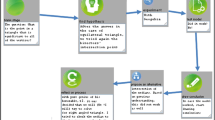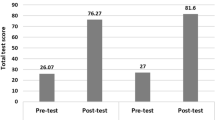Abstract
The importance of teachers developing adaptive instructional practices consistent with metaphor of whole-class scaffolding has been well documented. However, teachers’ development of such practices is currently not well understood. We draw on a 5-year professional development (PD) design experiment in which a group of middle school mathematics teachers developed aspects of such practices. We address questions of how can teachers’ development of instructional practices consistent with whole-class scaffolding be supported, and what challenges should be anticipated when designing to support such development? Findings indicate that leveraging teachers’ existing practices and concerns was important in supporting them to focus on students’ mathematical reasoning and develop adaptive practices. We discuss how the notion of whole-class scaffolding can orient the design of PD activities that remain grounded in classroom practice, and also consider how this notion can be further refined through analyses of teachers’ learning in PD settings.




Similar content being viewed by others
Notes
The research team included the authors, Kay McClain, Chrystal Dean, Teruni Lamberg, Qing Zhao, Melissa Gresalfi, Lori Tyler, and Jose Luis Cortina.
At the beginning of years 3–5, some teachers left the group while others joined. Analysis of the changes in group membership (Visnovska, 2009) revealed that the practices of the group were reestablished during the initial PD sessions that were conducted after new teachers joined the group.
References
Ball, D. L. (1993). With an eye on the mathematical horizon: Dilemmas of teaching elementary school mathematics. Elementary School Journal, 93(4), 373–397.
Ball, D. L. (2001). Teaching, with respect to mathematics and students. In T. Wood, B. S. Nelson, & J. Warfield (Eds.), Beyond classical pedagogy: Teaching elementary school mathematics (pp. 11–22). Mahwah, NJ: Lawrence Erlbaum.
Boaler, J. (1998). Open and closed mathematics: Student experiences and understandings. Journal for Research in Mathematics Education, 29, 41–62.
Carpenter, T. P., Blanton, M. L., Cobb, P., Franke, M., Kaput, J. J., & McClain, K. (2004). Scaling up innovative practices in mathematics and science. Retrieved 1 Oct 2015. http://ncisla.wceruw.org/publications/reports/NCISLAReport1.pdf.
Carpenter, T. P., & Fennema, E. (1992). Cognitively guided instruction: Building on the knowledge of students and teachers. International Journal of Educational Research, 16, 457–470.
Carpenter, T. P., Fennema, E., Franke, M. L., Levi, L., & Empson, S. B. (2000). Cognitively guided instruction: A research-based teacher professional development program for elementary school mathematics. Madison, WI: National Center for Improving Student Learning and Achievement in Mathematics and Science.
Carpenter, T. P., & Lehrer, R. (1999). Teaching and learning mathematics with understanding. In E. Fennema & T. A. Romberg (Eds.), Classrooms that promote mathematical understanding (pp. 19–32). Mahwah: Erlbaum.
Cobb, P. (1999). Individual and collective mathematical development: The case of statistical data analysis. Mathematical Thinking and Learning, 1(1), 5–43.
Cobb, P., & McClain, K. (2001). An approach for supporting teachers’ learning in social context. In F. L. Lin & T. Cooney (Eds.), Making sense of mathematics teacher education (pp. 207–232). Dordrecht: Kluwer.
Cobb, P., McClain, K., & Gravemeijer, K. (2003). Learning about statistical covariation. Cognition and Instruction, 21, 1–78.
Cobb, P., & Whitenack, J. (1996). A method for conducting longitudinal analyses of classroom videorecordings and transcripts. Educational Studies in Mathematics, 30, 213–228.
Coburn, C. E., & Russell, J. L. (2008). District policy and teachers’ social networks. Educational Evaluation and Policy Analysis, 30(3), 203–235.
Dean, C. (2005). An analysis of the emergence and concurrent learning of a professional teaching community. Dissertation, Vanderbilt University, Nashville, TN. Retrieved 1 Oct 2015. http://etd.library.vanderbilt.edu/available/etd-07152005-115218/unrestricted/CDean.pdf.
Dewey, J. (1913/1975). Interest and effort in education. Carbondale: Southern Illinois University.
Fennema, E., Carpenter, T. P., Franke, M., & Carey, D. A. (1993). Learning to use children’s mathematics thinking: A case study. In R. B. Davis & C. A. Maher (Eds.), Schools, mathematics, and the world of reality. Boston: Allyn and Bacon.
Fennema, E., Carpenter, T. P., Franke, M. L., Levi, L., Jacobs, V. R., & Empson, S. B. (1996). A longitudinal study of learning to use children’s thinking in mathematics instruction. Journal for Research in Mathematics Education, 27, 403–434.
Franke, M. L., & Kazemi, E. (2001). Learning to teach mathematics: Developing a focus on students’ mathematical thinking. Theory into Practice, 40(2), 102–109.
Glaser, B. G., & Strauss, A. L. (1967). The discovery of grounded theory: Strategies for qualitative research. New York: Aldine.
Gravemeijer, K. (1994). Educational development and developmental research. Journal for Research in Mathematics Education, 25, 443–471.
Gravemeijer, K. (2004). Local instruction theories as means of support for teachers in reform mathematics education. Mathematical Thinking and Learning, 6, 105–128.
Grossman, P., Hammerness, K., & McDonald, M. (2009). Redefining teaching, re-imagining teacher education. Teachers and teaching: Theory and practice, 15(2), 273–289.
Hiebert, J., Carpenter, T. P., Fennema, E., Fuson, K. C., Wearne, D., Murray, H., & Human, P. (1997). Making sense: Teaching and learning mathematics with understanding. Portsmouth: Heinemann.
Hiebert, J., & Grouws, D. (2007). The effects of classroom mathematics teaching on students’ learning. In F. K. Lester (Ed.), Second handbook of research on mathematics teaching and learning (pp. 371–404). Reston: NCTM.
Hiebert, J., Stigler, J. W., Jacobs, J. K., Givvin, K. B., Garnier, H., & Smith, M. S. (2005). Mathematics teaching in the United States today (and tomorrow): Results from the TIMSS 1999 Video Study. Educational Evaluation and Policy Analysis, 27, 111–132.
Hodge, L. L., Visnovska, J., Zhao, Q., & Cobb, P. (2007). What does it mean for an instructional task to be effective? In J. Watson & K. Beswick (Eds.), Proceedings of the 30th annual meeting of the Mathematics Education Research Group of Australasia (Vol. 1, pp. 392–401). Hobart: MERGA.
Kazemi, E., & Hubbard, A. (2008). New directions for the design and study of professional development. Journal of Teacher Education, 59(5), 428–441.
Lampert, M. (2001). Teaching problems and the problems of teaching. New Haven: Yale University.
Makar, K. (2012). The pedagogy of mathematics inquiry. In R. Gillies (Ed.), Pedagogy: new developments in the learning sciences (pp. 371–397). New York: Nova Science.
McClain, K. (2002). Teacher’s and students’ understanding: The role of tools and inscriptions in supporting effective communication. Journal of the Learning Sciences, 11(2&3), 217–249.
Schifter, D. (1998). Learning mathematics for teaching: From a teachers’ seminar to the classroom. Journal of Mathematics Teacher Education, 1, 55–87.
Schifter, D. (2001). Learning to see the invisible: What skills and knowledge are needed to engage with students’ mathematical ideas? In T. Wood, B. S. Nelson, & J. Warfield (Eds.), Beyond classical pedagogy: Teaching elementary school mathematics (pp. 109–134). Mahwah: Lawrence Erlbaum.
Simon, M. A. (2000). Research on the development of mathematics teachers: The teacher development experiment. In A. E. Kelly & R. A. Lesh (Eds.), Handbook of research design in mathematics and science education (pp. 335–359). Mahwah: Erlbaum.
Simon, M. A., & Tzur, R. (1999). Explicating the teacher’s perspective from the researchers’ perspectives: Generating accounts of mathematics teachers’ practice. Journal for Research in Mathematics Education, 30(3), 252–264.
Simon, M. A., Tzur, R., Heinz, K., Kinzel, M., & Smith, M. S. (2000). Characterizing a perspective underlying the practices of mathematics teachers in transition. Journal for Research in Mathematics Education, 31, 579–601.
Smit, J., & van Eerde, D. (2011). A teachers learning process in dual design research: Learning to scaffold language in a multilingual mathematics classroom. ZDM - The International Journal on Mathematics Education, 43, 889–900.
Smit, J., van Eerde, D., & Bakker, A. (2013). A conceptualisation of whole-class scaffolding. British Educational Research Journal, 39(5), 817–834.
Stein, M. K., Engle, R. A., Smith, M. S., & Hughes, E. K. (2008). Orchestrating productive mathematical discussions: Five practices for helping teachers move beyond show and tell. Mathematical Thinking and Learning, 10, 313–340.
Sullivan, P., Clarke, D., & Clarke, B. (2013). Teaching with tasks for effective mathematics learning. New York: Springer.
Treffers, A. (1987). Three dimensions: A model of goal and theory description in mathematics instruction—The Wiskobas Project Dordrecht. The Netherlands: Reidel.
Visnovska, J. (2009). Supporting mathematics teachers’ learning: Building on current instructional practices to achieve a professional development agenda. Dissertation, Vanderbilt University, Nashville, TN. Retrieved 1 Oct 2015. http://etd.library.vanderbilt.edu/available/etd-05292009-171404/unrestricted/Visnovska_Dissertation.pdf.
Wenger, E. (1998). Communities of practice. New York: Cambridge University Press.
Wood, D., Bruner, J., & Ross, G. (1976). The role of tutoring in problem-solving. Journal of Child Psychology and Psychiatry, 17(2), 89–100.
Zhao, Q., Visnovska, J., Cobb, P., & McClain, K. (2006). Supporting the mathematics learning of a professional teaching community: Focusing on teachers’ instructional reality. Paper presented at the annual meeting of the American Educational Research Association conference, San Francisco.
Author information
Authors and Affiliations
Corresponding author
Rights and permissions
About this article
Cite this article
Visnovska, J., Cobb, P. Learning about whole-class scaffolding from a teacher professional development study. ZDM Mathematics Education 47, 1133–1145 (2015). https://doi.org/10.1007/s11858-015-0739-7
Accepted:
Published:
Issue Date:
DOI: https://doi.org/10.1007/s11858-015-0739-7




